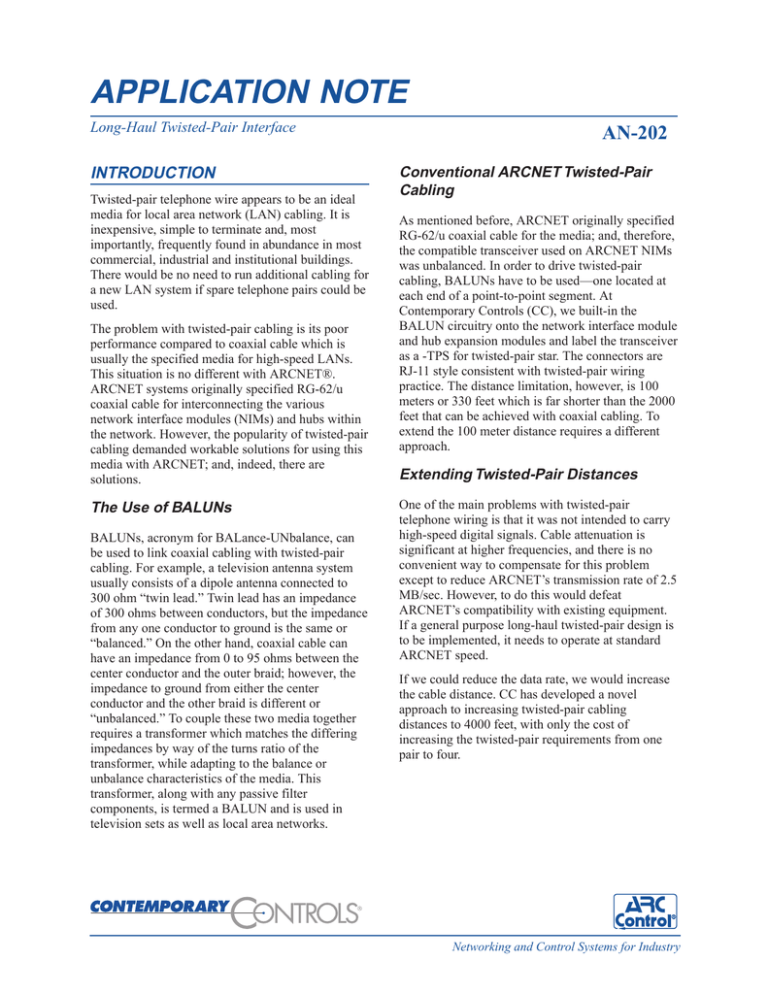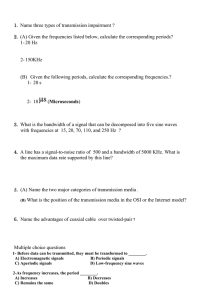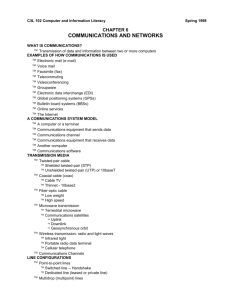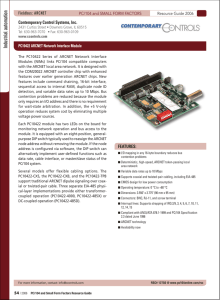Long-Haul Twisted-Pair Interface
advertisement

APPLICATION NOTE Long-Haul Twisted-Pair Interface INTRODUCTION Twisted-pair telephone wire appears to be an ideal media for local area network (LAN) cabling. It is inexpensive, simple to terminate and, most importantly, frequently found in abundance in most commercial, industrial and institutional buildings. There would be no need to run additional cabling for a new LAN system if spare telephone pairs could be used. The problem with twisted-pair cabling is its poor performance compared to coaxial cable which is usually the specified media for high-speed LANs. This situation is no different with ARCNET®. ARCNET systems originally specified RG-62/u coaxial cable for interconnecting the various network interface modules (NIMs) and hubs within the network. However, the popularity of twisted-pair cabling demanded workable solutions for using this media with ARCNET; and, indeed, there are solutions. The Use of BALUNs BALUNs, acronym for BALance-UNbalance, can be used to link coaxial cabling with twisted-pair cabling. For example, a television antenna system usually consists of a dipole antenna connected to 300 ohm “twin lead.” Twin lead has an impedance of 300 ohms between conductors, but the impedance from any one conductor to ground is the same or “balanced.” On the other hand, coaxial cable can have an impedance from 0 to 95 ohms between the center conductor and the outer braid; however, the impedance to ground from either the center conductor and the other braid is different or “unbalanced.” To couple these two media together requires a transformer which matches the differing impedances by way of the turns ratio of the transformer, while adapting to the balance or unbalance characteristics of the media. This transformer, along with any passive filter components, is termed a BALUN and is used in television sets as well as local area networks. AN-202 Conventional ARCNET Twisted-Pair Cabling As mentioned before, ARCNET originally specified RG-62/u coaxial cable for the media; and, therefore, the compatible transceiver used on ARCNET NIMs was unbalanced. In order to drive twisted-pair cabling, BALUNs have to be used—one located at each end of a point-to-point segment. At Contemporary Controls (CC), we built-in the BALUN circuitry onto the network interface module and hub expansion modules and label the transceiver as a -TPS for twisted-pair star. The connectors are RJ-11 style consistent with twisted-pair wiring practice. The distance limitation, however, is 100 meters or 330 feet which is far shorter than the 2000 feet that can be achieved with coaxial cabling. To extend the 100 meter distance requires a different approach. Extending Twisted-Pair Distances One of the main problems with twisted-pair telephone wiring is that it was not intended to carry high-speed digital signals. Cable attenuation is significant at higher frequencies, and there is no convenient way to compensate for this problem except to reduce ARCNET’s transmission rate of 2.5 MB/sec. However, to do this would defeat ARCNET’s compatibility with existing equipment. If a general purpose long-haul twisted-pair design is to be implemented, it needs to operate at standard ARCNET speed. If we could reduce the data rate, we would increase the cable distance. CC has developed a novel approach to increasing twisted-pair cabling distances to 4000 feet, with only the cost of increasing the twisted-pair requirements from one pair to four. Networking and Control Systems for Industry What is needed is a “reclocking hub” that synthesizes a new ARCNET signal, without bit jitter, from the jittery signal sent via the twisted-pair cable. The MOD HUBplus enclosure contains the necessary reclocking timing generator at the expense of more sophisticated electronics. MXP-4TP EXPANSION MODULE The MXP-4TP is a double-wide expansion module (occupies two slots) that is installed into either a MHP-S or MHP-L MOD HUBplus Modular Active Hub. The MXP- 4TP accepts the backplane signals from the MOD HUBplus and generates four “miniARCNET” signals, each transmitting at a 625 Khz rate (¼ the rate of ARCNET). Each twisted-pair contains information from the original 2.5 MB/s ARCNET signal. The four signals are recombined at the other end of the twisted-pairs by another MXP-4TP which logically “ORs” the signals, thereby reconstructing the original ARCNET signal without diminishing the effective throughput of ARCNET. MOD HUBplus The MOD HUBplus active hub was designed to accommodate extended range ARCNET applications over non- conventional media which, by their nature, generate excessive bit jitter for conventional hubs. Conventional hubs simply reproduce the signal received on one of its ports to all remaining ports. The MOD HUBplus incorporates anti-jitter circuitry which captures the incoming signal in a short first infirst out (FIFO) register and retransmits the data using a jitter-free clock. In this way, induced bit jitter is eliminated at each hub preventing its accumulation within the network, therefore, making specialized cabling applications possible. The downside to this approach is that hub delay in reclocking hubs is more than conventional hubs. CC specifies a MOD HUBplus hub to have a 1200 ns worst case delay versus 250 ns for a standard MOD HUB. This increase is usually insignificant but should be considered in networks approaching 20,000 feet in end-to-end network distances. Another feature of the MOD HUBplus is that it has built-in two coaxial star (-CXS) ports which can accept one or two NIM connections or one to two cascade hub connections. MOD HUBplus enclosures are available in two sizes: a four slot MHP-S and a 12 slot MHP-L. Remember that each MXP-4TP requires 2 slots and, therefore, a MHP-S can accommodate up to two MXP-4TPs while the MHP-L can handle up to six. The MXP-4TP contains two modules attached in a piggyback fashion. One module is called the transmitter and the other the receiver. In a modular hub, such as the MOD HUBplus, ARCNET signals signifying a logic “1” are present on the backplane of the hub as pulses P1 and P2. Both of these signals are 100 ns wide with P2 delayed from P1 by 100 ns. A logic “0” does not generate either a P1 or P2. The transmitter of the MXP-4TP receives the P1 signal and generates an ARCNET dipulse, but at ¼ the speed, onto one of the twisted-pairs. When the next P1 is received, a second dipulse is generated down the second twisted-pair. This sequence continues in a “Gatling gun” fashion (four barrels firing in succession) every time a P1 is received. If a logic “0” occurs, there is no P1 activity; and the Gatling gun remains cocked at the next barrel position awaiting to be fired. To implement these mini-ARCNET signals requires four separate timing generators (using delay lines) and four separate transformer coupled dipulse generators. TOPOLOGY Likewise, the receiver module requires four separate receivers consisting of an adjustable gain amplifier and a matched filter tuned to the low-speed ARCNET signal. The gain of the amplifier compensates for the varying distances encountered in an installation and must be set once. The four miniARCNET signals are received and logically ORed together in order to reconstruct the original ARCNET signal. This recombined signal is then applied back onto the MOD HUBplus backplane for retransmission to other ARCNET nodes. To connect two NIMs with long-haul twisted-pair cabling requires two MOD HUBplus enclosures each with one MXP- 4TP installed. Connect each NIM with a short length of coaxial cable to one of the two ports on the MOD HUBplus. Then connect twistedpairs between each MXP- 4TP. If the NIMs have coaxial bus transceivers (-CXB), then connect the MOD HUBplus to one end of the bus segment without a tee connector and terminator. MXP-4TPs must be wired in either a star or distributed star configuration. No bus connections are allowed on the twisted-pair segment. For example, to connect four distant NIMs using twistedpair cabling in a star configuration use a MHP-S and MXP- 4TP near each NIM. Connect the NIM to the MHP-S with coaxial cable. In the center, use a MHP-L and four MXP-4TPs. Connect the twisted- In theory, everything should work; however, twistedpair cabling introduces several problems due to its poor high-speed performance. Significant bit jitter is experienced during the encoding/decoding process that propagates through conventional hubs resulting in unreliable operation by accumulating the jitter. 2 pairs between a MXP- 4TP near the NIM to one of the MXP-4TPs located in the center. If the remainder of the network uses conventional coaxial cable technology, it is unnecessary to use more MOD HUBplus hubs. Simply use conventional MOD HUBs and a coaxial cable connection to a coaxialstar port on either the MHP-S or MHP-L. Pick the entry equal to, or lower than, the estimated length of the segment. For example, if the segment is estimated to be 2100 feet long, pick the entry under 2000 feet (OCCO). With the MXP-4TP removed and orientated with the face plate on your right, look at the row of DIP switch banks. The word OPEN appears on top of the switch (although upside down) and the numbers 4 through 1 are on the bottom (although upside down). The chart is organized so that switch settings correspond to the numbers and the location of the switch positions on the DIP switch bank. In our example, we want to set the range to 2000 feet (OCCO). From the chart, 3 and 2 are to be closed and 4 and 1 opened. Using a pointed object, push rocker switches 4 and 1 at the OPEN side in order to open the switches. Do the opposite for 3 and 2 since they are to be in the closed position. Do the same for all four switch banks. Cabling We specify the use of two types of cable. Either use Belden's #9566 or AT&T's #AK-186BKMA-100. Other cables will work, but it is difficult to test all varieties. The common situation is that the cable already exists and the building owner wants spare telephone pairs to be used. Follow these rules when specifying cable: — Segment length cannot exceed 4000 feet. — Telephone pairs are to be in the same bundle. If you are not sure of the actual distance, estimate the best you can. The switch settings are very broad at the longer distances and capable of spanning a wide range. (At the end of this application note, we discuss the laboratory results of a test conducted to determine the sensitivity of gain setting for various lengths of cable.) Once the switches are set, insert the module and power-up the enclosure. Make sure you set the switches the same on the MXP-4TP located at the other end of your segment. — No stubs allowed. Connections must be point-topoint since unused stubs cause reflections. Disconnect unused stubs. Wiring The connection rules are simple. Correspondingly connect each wire of each pair to the same point on each MXP-4TP. The field connector is removable. Insert a small screwdriver into the side of the connector, in order to open the jaws of the connector, and simply push the stripped wire into the front opening. Removal of the screwdriver releases the jaws onto the wire. Connections are marked as pairs 1 through 4 with a (+) and (–) sign. Do not invert the signals. The (+) connection on any one pair must be made to the (+) connection at the other end. Wire to the DATA side of the connector. DIP Switch Bank Settings Distance (feet) 300 600 900 1200 1400 1700 2000 2300 2500 2800 3100 3400 3600 3900 *4200 *4500 NOTE: The system will work even if two pairs were swapped at any one side, as long as no phase inversion occurred. However, for maintenance sake, we recommend that cable pairs be connected to corresponding terminals. All four cable pairs must be made. A loss of one cable will render the system useless. Distance Setting With the power off, remove the MXP-4TP. It is necessary to know the approximate distance of the run in order to set the amplifier gains. There are four banks of four-position DIP switches. Each switch bank MUST be set the same as the others on both sides of a segment. Table 1 has been provided for convenience referencing the distance of the segment. Notes: 3 4 O C O C O C O C O C O C O C O C 3 O O C C O O C C O O C C O O C C 2 O O O O C C C C O O O O C C C C 1 O O O O O O O O C C C C C C C C O = open C = close. Select the setting that is equal to or just below the estimated segment distance. * If one of the MXP-4TP lights is out, that pair is not communicating. If the lights flicker, the gain setting may be improper. First, check your wiring; second, attempt setting the gain to a different value. Although the MXP-4TP is specified to operate up to 4000 feet, greater distances have been achieved with good results but with reduced margins.“ Piggy-Backing Onto Telephone Circuits Table 1—DIP Switch Bank Settings When no twisted-pair cables are available, we could share existing telephone circuits if a private branch exchange (PBX) is available. Telephones function in a star topology with individual telephone circuits attached to a central switch. As part of our optimized twisted-pair transceiver, a crossover network is implemented with a high-pass filter for ARCNET signals and low-pass filter for the voice circuit and ring signal. Using this approach, no additional twisted-pair circuits are needed beyond the ones already dedicated for telephone use. Indicator Lights There are indicator lights present on the timing module and MXP-4TP that can be quite helpful to the installer. The timing module indicators, when lit, are defined as follows: RECON—A network reconfiguration is taking place. (Note: The RECON detection is only valid if the TIMING light is on.) +PWR—The +5 volt power supply within the hub is functioning properly. The sharing of telephone circuits with ARCNET is not normally recommended due to the unpredictability of the installation and the potential for objectional levels of cross-talk that may occur when four telephone circuits pass through the MXP4TP. If spare twisted-pairs are available, we recommend dedicating them to ARCNET communications only. If there are simply no unused pairs available, use active telephone circuits instead by breaking the connection between the telephone and the PBX in two places and by installing a MHP with MXP-4TP at each of the two locations. Towards the PBX side, connections from the PBX are made to a PHONE pair marked (+) and (–) on one of the MXP-4TPs. At the telephone end, make the same connection to the corresponding pair marked (+) and (–) without signal inversion to the other MXP-4TP. Between the two MXP-4TPs, connect their DATA pairs together to corresponding terminals. In this case, it is important to make corresponding connections. Complete the installation by setting the gain switches as previously discussed. –PWR—The –5 volt power supply within the hub is functioning properly. TIMING—A valid ARCNET signal is present from either one of the two coaxial ports or from the twisted-pair cable; and the internal timing circuitry within the hub is properly regenerating the signal. In addition to the above indicators, the timing module has two unmarked indicators adjacent to the BNC connectors. These are port activity indicators that light when the port is “receiving” data from a device connected to the port. In addition to the timing module, the MXP- 4TP has four LED indicators—one for each twisted-pair cable. The uppermost light corresponds to DATA pair 1. With no cables connected to either of the coaxial ports or twisted-pair ports, the RECON light should be on as well as the +PWR and –PWR lights. The TIMING light should be off. Connect a valid ARCNET signal to one of the coaxial ports, and its corresponding activity light should come on as well as the TIMING light. Notice that the MXP-4TP lights remain out. This is because these lights indicate received data and not transmit data. The MXP-4TP is, however, transmitting at this time. Connect the twisted-pair cable to the MXP-4TP. If a valid ARCNET signal exists on the other end of the cable, the two ARCNET nodes should link up, thereby extinguishing the RECON light. The four LEDs on the MXP-4TP should be solidly lit. This is the proper state of the LED indicators. Using Phone Connections for Checkout If piggybacking onto phone circuits is not needed, it is still possible to utilize the PHONE connections to assist in checkout. If two inexpensive wire-based intercoms are available, connect one set to a PHONE pair on one MXP-4TP and connect the other to intercom to the corresponding PHONE pair on the other MXP-4TP. Connect the two MXP-4TPs together using the DATA connections as previously discussed, and two installers can communicate with one another while ARCNET traffic is being passed. 4 This could be helpful when “buzzing out” the circuits, except the intercom is the buzzer. Move the intercom connections down each pair on both sides to test for wiring integrity communicating to one another before moving connections. This could speed installation and checkout. switches were changed until an ARCNET confidence test would fail due to either too high or too low of a setting. The test was repeated for increasing lengths of cable and the results plotted. For example, at 2000 feet a gain setting from 900 to 2000 feet would function correctly while all other settings would not. Use Table 2 to determine actual switch settings. It was determined that gain setting is much more critical at the lower distances than at the higher distances. Since most applications involve distances greater than 1000 feet, gain setting accuracy becomes less of an issue. Use the accompanying chart as a guide, but remember that this was developed using AT&T cable. Results should be similar for other cables; however, the chart may become skewed if attenuation varies from that of the AT&T cable. LABORATORY RESULTS CC performed a test in its laboratory in order to ascertain the sensitivity of gain settings with respect to the actual distances involved. From a large reel of AT&T's #AK-186BKMA-100 cable, segments were cut in 500, 500, 500, 500 and 2750 foot lengths. Using a patch panel, overall lengths of 500, 1000, 1500, 2000, 2750, 3250, 3750, 4250 and 4750 feet could be selected. At each distance, the gain dip M XP-4TP GAIN SWITCH SETTING SENSITIVITY DISTANCE IN FEET 0 D 300 I 600 P S 12 0 0 14 0 0 I 17 0 0 C H 1000 1500 2000 2750 3250 3750 4250 4750 900 W T 50 0 2000 2300 2500 S 2800 E 3 10 0 T T 3400 I 3600 N 3900 G 4200 S 4500 SHADED AREAS INDICATE OPERATING RANGE OF EACH DIP SWITCH SETTING FOR A GIVEN DISTANCE Table 2—Gain Switch Setting Sensitivity 5 CC also learned additional information when making the test. An attempt was made to use two cable pairs from one cable and another two cable pairs from another cable. Both cables were thought to be 500 feet in length. Unreliable performance was experienced regardless of gain setting. CC speculated that additional bit jitter was introduced due to the fact that the cable lengths may not have been equally matched. The MXP-4TP relies upon the fact that signals sent down each of the four cable pairs can be recombined at the other end without any additional phase shift or time delay. Unequal delays in the four cable pairs result in unequal spacing of logic “1” signals which results in data errors. Customers have also reported to CC that if any stub exists in the cabling run, unreliable operation will occur. Frequently, it is difficult to determine if a stub exists. Make sure that all punch down panels are examined for stubs and disconnect them accordingly. Also, examine the punch down connections themselves or reterminate the connections. Connections result in slight impedance mismatches that can effect the high speed data being sent. The MXP-4TP card makes it possible to connect ARCNET segments from 300 feet up to 4000 feet. It has been our experience that once a MXP-4TP is properly installed, the link has proven highly reliable. Contemporary Control Systems, Inc. 2431 Curtiss Street l Downers Grove, Illinois 60515 l USA TEL +1-630-963-7070 FAX +1-630-963-0109 E-MAIL info@ccontrols.com WWW http://www.ccontrols.com ARCNET is a registered trademark of Datapoint Corporation. ARC Control and Contemporary Controls are registered trademarks of Contemporary Control Systems, Inc. Other product names may be trademarks or registered trademarks of their respective companies. Specifications are subject to change without notice. © Copyright Contemporary Control Systems, Inc. October 2002







